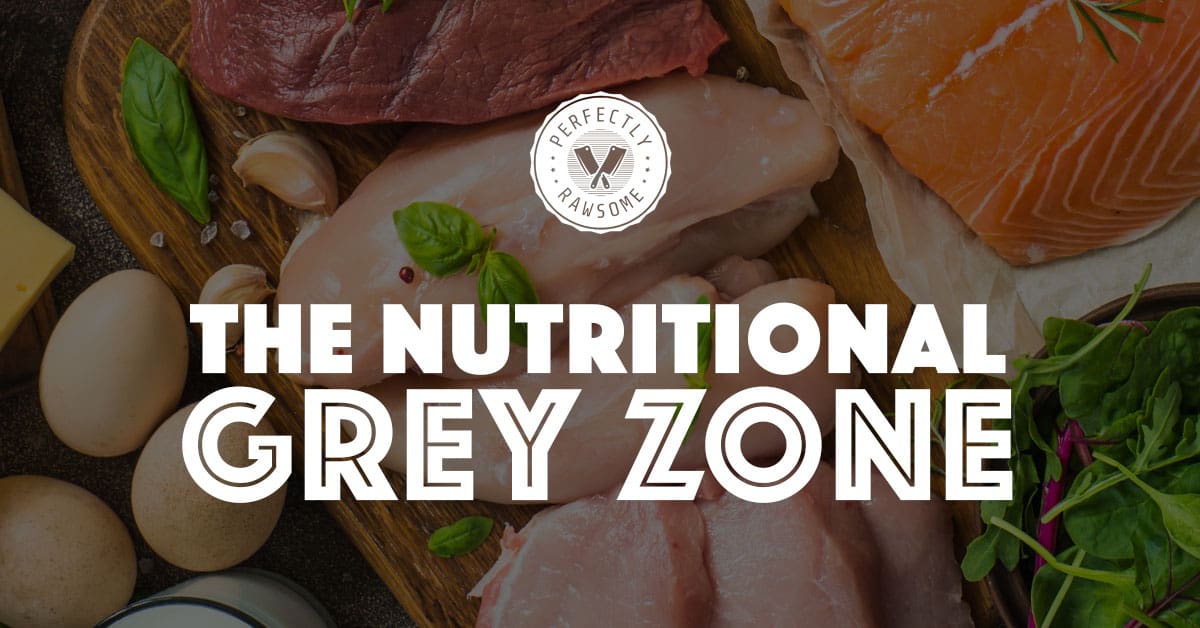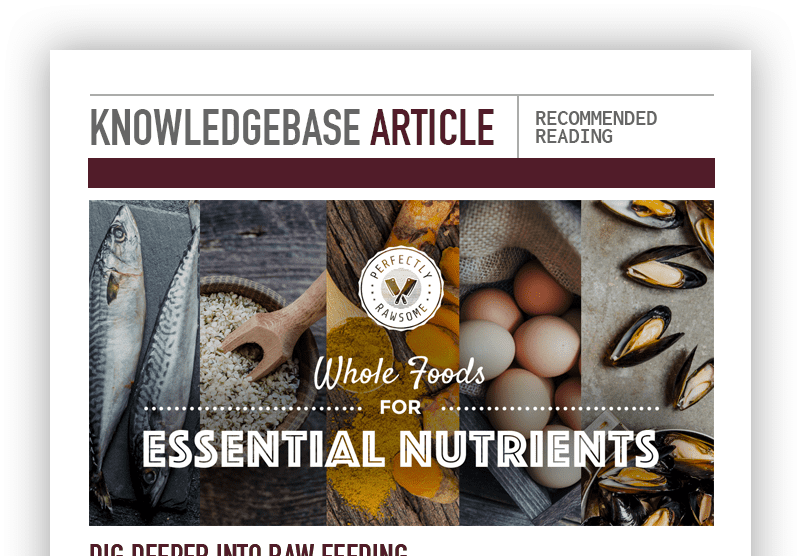Nutrition as a whole is a very grey area, there is no black and white. Even professionals do not have all of the data or answers, and many experts disagree on various aspects of nutrition. Professionals and pet owners can only do their best to work with the information currently available.
Due to the diverse opinions of nutritionists, pet owners may become overwhelmed by the daunting amount of conflicting information. Unfortunately, some pet owners may abandon fresh feeding in their confusion. Others are constantly plagued with fears that the diet they are providing is not perfectly balanced. While providing a well balanced diet is important, it is also helpful to understand the grey areas within nutrition in order to alleviate the excessive anxiety over achieving perfection.
There are five focus points when identifying variables that contribute to the nutritional grey zone. It is important to acknowledge these areas when feeding a home prepared raw diet.
AAFCO, NRC, & FEDIAF
There are multiple nutritional guidelines for dogs and cats.
Ingredient Variety in Raw Diets
Variety does not ensure balance, but it can help.
Individual Requirements
Individual pets may have certain nutrient requirements that vary from the average guidelines.
Average Nutritional Data on Food Stuffs
The nutritional data available on various human grade foods are only averages.
Growth & Development Diet Balance
While puppies and kittens do require daily balance, sometimes perfection is not possible.
It is important to remember that the nutritional grey zone does not refute the data that is available today. Pet parents should maintain a balance between the information currently available and the unknown.

Nutritional Guidelines: AAFCO, NRC, & FEDIAF
AAFCO, NRC, and FEDIAF are all organizations which set nutritional guidelines for dogs, cats, and other domestic animals. These guidelines typically provide the minimum amount of each essential nutrient that is required for a balanced diet. These include amino acids, fatty acids, water-soluble vitamins, fat-soluble vitamins, macrominerals, and microminerals.
AAFCO (Association of American Feed Control Officials)
In order to be labelled “complete and balanced” in the USA, commercial pet food must meet AAFCO requirements either through feeding trials or formulation.
NRC (National Research Council)
The NRC is a private research organization which publishes reports on the nutrient requirements of dogs and cats.
FEDIAF (The European Pet Food Industry)
In the European pet food industry, FEDIAF is the organization which publishes nutrient guidelines for pet food.
In addition to providing minimum requirements, these guidelines typically provide a Recommended Allowance (RA) for most nutrients and Safe Upper Limit (SUL) for some nutrients. This means that there is a range of sufficient levels for various essential nutrients. There is not one exact number for each nutrient. Therefore, there is some leeway when formulating pets diets. The overall diet must meet the minimum requirements for each essential nutrient, however it is encouraged to meet or exceed RA while staying within the identified SUL.
Each of these organizations have different nutritional guidelines, all of which disagree on what constitutes a complete and balanced diet. There is no consensus on what guideline is best or “right”. Therefore, the statement “complete and balanced” should be taken with a grain of salt. It is up to the pet parent to research each guideline then decide which is appropriate for their pet.
Variety in Raw Diets
Many pet owners assume that feeding a variety of meats, bones, and organs will provide all essential nutrients. While protein variety is a major component of a balanced raw diet, it does not necessarily fulfill requirements for every essential nutrient. Feeding the right variety of whole foods is important to fill the gaps. When building a DIY raw diet, begin by choosing a diet style. There are multiple raw diet types, below are a few examples:
Once a feeding style has been chosen, the pet owner must construct the diet to meet their chosen nutrient guideline. One feeding style is not necessarily better than another, it is up to the pet parent to choose what works best for them and their pet. Both BARF and PMR have common nutrient deficiencies that need to be addressed with certain whole foods.
Whole Foods for Essential Nutrients
An all raw meat diet frequently lacks essential nutrients for optimal health. Learn more about whole foods for essential nutrients.
Seek Professional Guidance When Needed Tip 1
If protein variety within the feeding style is limited, it may be helpful to contact a nutritionist in order to ensure the diet meets all essential nutrients (ie, chicken only diets).
Individual Requirements
An additional grey area within nutrition is the fact that some pets have individual needs. Their requirements for certain essential nutrients may differ from the average guidelines. This can be due to various factors such as disease, life stage and genetic markers.
Disease
Certain medical conditions may require a higher or lower amount of certain essential nutrients. For example, the amount of copper in the diet should be reduced for liver disease, and phosphorus is reduced for kidney disease.
Life Stage
Nutrient requirements often differ depending on the life stage of the animal. Pregnant & lactating female dogs as well as puppies have different nutrient requirements compared to normal adult dogs.
Genetics
Genetic markers can also result in nutrient requirements that diverge from the standard guidelines. Dalmations which carry the gene for High Uric Acid (Hyperuricosuria and Hyperuricemia or Urolithiasis, HUU) will need a low purine diet, whereas this is not a concern for most normal dogs. Siberian huskies are known to have issues with zinc deficiency, and some white dogs of several breeds often struggle with tear stains due to excessive iron in the diet.
The standard nutritional guidelines will not be appropriate for every individual. Not all pets will fit the cookie-cutter mold, and pet owners will need to adjust the diet to accommodate their individual pet’s needs.
Nutritional Data on Food Stuffs
In order to formulate a pet’s diet to meet any one of the nutritional standards, the data on the nutrient content of the foods fed is required. This can be obtained from several sources such as the USDA food database and the New Zealand food composition database. It is important to note that these nutritional databases only provide data on foods that are consumed by humans. They do not include the nutritional data from bones.
In addition to the differing nutritional guidelines for pet food, nutritional data on food is not exact. Averages in nutritional analysis, differences in farming practices, limited data on raw meaty bones, and unavailable data on certain foods further contributes to the grey zone in nutrition.
Laboratory Food Testing
In order to obtain nutritional data, a particular food item is sent to a laboratory in several batches. The nutritional analysis provided by the laboratory will be an average of the multiple batches tested. A margin for fluctuation will also be included in the results. Therefore, one should not assume that the nutritional analysis provided for a specific food is an exact representation of the food item they may purchase. It is only an average guideline.
Multiple Farming Practices
There are varying farming practices when raising livestock for food. Commercial farmed livestock are nutritionally different than grass-fed animals; and the same sentiment can be said when comparing farmed livestock to wild game. The wide array of variables that contributes to raising animals for meat has an effect on the nutritional content of the animal itself. The nutritional data available simply is not extensive enough to provide the nutrient analysis on all foods from different farming methods.
Limited Data on RMBs
The nutritional data for any raw meaty bone from sources like USDA will only provide the nutritional information on the meat and fat portion. These databases do not provide the nutritional analysis of the bone itself. However, some of this data can be found in two books published by Monica Segal.
Unavailable Nutritional Data
Many food items commonly used in raw feeding do not have any nutritional data available, such as duck heads. There may be times when a pet owner would like to feed whole prey or a large recreational item for enrichment however the nutritional data does not exist; but it is not sensible to avoid feeding food ingredients simply because the nutritional data is not available.
Providing a rotation of food ingredients helps to makeup for any potential pitfalls that may occur due to these variables that effect nutritional analysis. It is encouraged to rotate proteins and other ingredients when possible and it is recommended to feed a minimum of three animal based proteins in a raw diet which helps with the factors discussed above.
However, it is best to rotate between individual ingredients as well – examples such as: raw meaty bones (chicken wings and turkey necks), fish (salmon and mackerel), organs (beef liver and lamb liver), and vegetables (broccoli and spinach).
Growth & Development Diet Balance
Growing puppies and kittens cannot regulate essential nutrients over time as well as adult dogs and cats. Therefore, it is important to provide a well balanced diet to puppies and kittens daily. Many pet owners are particularly worried about providing their puppy or kitten with a balanced diet, and are terrified of “messing up” and harming their pet.
While a significantly unbalanced diet does indeed hold the potential for harm, there is no need for excessive perfectionism and worry. Many pet owners are fully capable of educating themselves appropriately. It is important to recognize that perfection is not attainable as there is no one “perfect” method of feeding a raw diet.
Seek Professional Guidance When Needed Tip 2
If a pet owner truly does not feel capable of providing a well rounded diet to their puppy, it is encouraged for them to seek the guidance of a qualified nutritionist or feed an AAFCO balanced premade raw that is formulated for “All Life Stages.”
CLOSING COMMENTS
Nutrition is always evolving as more data becomes available. There is no single “right” way to create a raw diet for a dog or cat. However, for pet owners who wish to do it themselves, it is important to make a conscious effort to become educated on the subject to provide a well rounded diet while recognizing the nutritional grey zone:
Be Mindful of Lifestage Needs
Puppies and kittens need more careful calculations to achieve a daily balanced diet because balance over time is only attainable with adult dogs and cats.
Nutritional Guidelines Differ
There are multiple nutritional guidelines and their recommendations for essential nutrients all vary from one another.
Raw Diet Types Vary
PMR, BARF, and Keto diets are three examples of raw diet guidelines to follow when creating a raw diet.
Every Pet is an Individual
Each dog and cat is an individual and their diet should always be adjusted to accommodate individual needs which may contradict nutritional guideline recommendations.
Nutritional Data is Averages, Not Exacts
Most nutritional data on food ingredients are only completed on foods fit for human consumption and the information are only averages with a range to account for fluctuation.
These five points illustrate that there is a wide grey zone when dealing with nutrition. Maintaining a balance between knowing the nutritional requirements for a balanced diet and the nutritional grey zone is essential to ensuring a raw diet is nutritionally sufficient. However, perfectionism is unattainable and it is not sensible to avoid feeding foods simply because nutritional data is unavailable.

